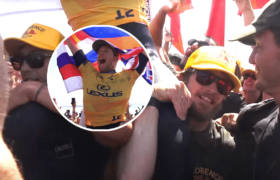A two-month road test of the Stacey Wave
Slave…
I picked up the Wave Slave from the Stacey
Factory in a Currumbin industrial estate, near neighbours
with the Balter beer brewery and a collection of panel beaters and
mechanics and other small factories. The talk is always how
manufacturing is dead in Australia and yet these thriving small
industrial hubs seem to be everywhere in our coastal regions.
Beer and surfboards: a recipe to Make Australia Great Again? I
read Wave Slave as Wage Slave which gave me a chuckle, seeing as I
am a contractor and a freelancer; the lowest of the low, apart from
the now almost extinct coastal dole bludger.
Lee Stacey is a Shaper/Board Builder working in the
high-performance space whose boards feel like they have been around
forever. First thought when fondled the Wave Slave was, ‘Whoa,
Simon Anderson Energy thruster 1981.’ It carries a heavy
imprint of the DNA of the early thruster: wide, thick tail block,
volume throughout the board, a full rail. At six-o mine felt a
little generously proportioned and if I had bought off the rack I
would have gone down an inch or two but that doesn’t bother me a
bit. I like to feel my ride, I like cushion in my ride. Volume is a
choice, a preference, above all, a fashion statement. It comes in
and out. I like ’em thin and curvy in Indo, better paddlers if I’m
nabbing a few after work and fighting a sweep and the clock. Gabe
Medina showed at Bells what extra volume can do as far as getting
rid of the defects in style.
I drove the board straight from Currumbin to Lennox Point, waxed
it (badly) and paddled out in three-to-four-foot point surf. Bit
ratty and mediocre but probably still better than most testing
tracks in the world. I finned it up with what was in the back of
the Camry, front fins for a quad and a medium rear fin. Straight
up, first wave that wide, thick tail-block got out of the hole and
planed like an overpowered bass boat. But I had no drive. I went A
to C instead of A to B, if you get my drift, which I mean
literally.
Fins are considered the epitome of the modern fractured-bullshit
marketing universe we inhabit, but I hold a contra view.
Even though they are. According to the Greenough school
of design thought,
to which I subscribe, good design is fine tuning. “Just about
anything will work if the handling is tuned in.”
Very quickly and imperceptibly the board disappeared under my
feet, in the sense that I had to give it no thought. I’ve never
ridden a board so easy to shred on. Sometime in the opening session
I popped and landed perfectly a clean backside air, only the second
one in my career as a – I prefer the term “competent” surfer to the
more accurate and devastating “upper intermediate” – lifelong
recreational donkey.
Two ways available for the rec surfer to tune the handling in.
Through customisation of the whole package in a surfer/shaper
relationship or, more easily, tinkering with the engine room, i.e
fins.
I’m no fin guru but I know what I like, and I know what works.
Wave Slave wanted more fin area to give more control over the
planing area in the tail block. The extremely helpful and
knowledgeable man at the factory, Liam, had suggested a large
upright fin and to stay away from too much rake. De-finning a
twinzer with a large, hand-foiled fin I took the Wave Slave
straight back to the Point with the larger fins.
The difference was profound.
The planing area was now under my command. Very quickly and
imperceptibly the board disappeared under my feet, in the sense
that I had to give it no thought. In my mind I nicknamed the board
the Eazy Shredda, because I’ve never ridden a board so easy to
shred on. The learning curve for anyone with a basic skill set is
insignificant. Sometime in the opening session I popped and landed
perfectly a clean backside air, only the second one in my career as
a – I prefer the term “competent” surfer to the more accurate and
devastating “upper intermediate” – lifelong recreational
donkey.
Does your quiver tend to the specialist or the generalist?
Under the house, mine is a bewildering array of specialised
equipment: bonzers, twinzers, channel-bottom quads, high-volume
guns, single fins, semi guns etc etc. All an attempt to answer some
specific question at a specific break for a certain set of
conditions, or some exploration down a rabbit hole of design
theory. Each board painstakingly “mastered” then filed away for the
right moment.
The missing link was a generalist high-perf sled, which I’d
avoided due to self-defeating contrarian tendencies and a
schizophrenic relationship to high performance. By that way of
thinking the answer to crowds and commercialism was to deliberately
hobble your own surfing, a kind of surfboard nihilism that has
somehow become a fashion statement and been brilliantly co-opted by
the surf-industrial complex. Nowadays I cleave more to the famous
statement of surf journalist Nick Carroll when he proclaimed, “High
performance is a gift from the Gods and woe betide those who refuse
that gift”.
In over two months, the lower or upper limit of the
Slave’s range have remained unknown to me. That is because the surf
has been two-to-four-foot, mostly mediocre, every day since then
and that fits perfectly in the boards remit. I imagine you could
push it lower and higher very easily. The board has remained what
it was in the opening session: the easiest of high-performance
shredders. It is a very demure, discreet surf companion. It demands
little and offers much.
Going about my lawful occasion in the day-to-day I hear of many,
many good men and good women struggling with surfboards,
rationalising their quivers.
Are you a quiver rationaliser? I admit this way of thinking is
alien to me (unless the tax man is threatening to send the debt
collectors around). I like to accumulate surfboards the way an Old
Testament potentate would accumulate children; as a measure of
wealth and plenitude.*
Even though it is psychologically unsound I would just as soon
rationalise my own family as rationalise my quiver.
Clean your teeth my son, you’re on Gumtree today. Chin up,
I’m sure you’ll go to a good, more fashionable family.**
If you are one of those despised quiver rationalisers then may I
suggest that the original DNA of the thruster is a very good place
to start for the generalist shredder and high-performance building
block. Andrew Kidman told me wide tails are the go for finding easy
planing speed and then the question is dialing in the control. Not
a hard task in the 21st century.
*My answer to environmental footprint. I never throw them away!
They never end up in landfill.
** This is actually illegal.
Examine the Wave Slave
here.
(Editor’s note: As part of these board reviews, which
are paid although no guarantee is given of the outcome, we’ve
employed a world-class pro surfer, who is masked, to give us a
little high-end shredding, as entertainment. See below.)








